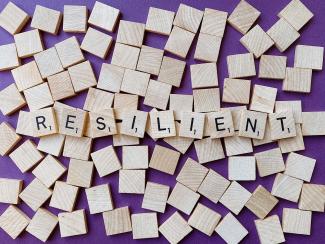Resilience: The art of bouncing back

What is resilience and how can we develop and nurture it? In the first of this two-part feature, speech & language therapist (SLT) Natalie Dade-Greaves hopes to bring some support for everyday life and for adapting to the changes the current health crisis brings as they unfold.
What does resilience mean to you? When have you had to be resilient?
Think about it.
The topic of resilience is particularly pertinent right now given the Covid-19 crisis. Indeed, some people who stammer may feel that current social restrictions and limited opportunities to interact affects their speech in different ways (in children, we know that changes to routine can affect stammering — see this Tips for Parents article from the Michael Palin Centre).
About me

One of my own experiences of needing to 'bounce back' was at the age of 24 when, after a year of struggling with my health and gradually losing my ability to walk, I was diagnosed with a brain tumour, forcing me to let go of everything I had worked to create and be. What I understood as 'my life' was deconstructed and I was taught my most valuable lesson. With determination I learnt to walk again, became a therapist, and now have the privilege of being part of the STAMMA volunteer team.
Recently I attended a workshop by Sarah Caughter, a specialist SLT at The Michael Palin Centre for children and adults who stammer. Sarah is a trainer for 'Reaching In, Reaching Out' (RIRO), a Canadian programme promoting resilience in children under 8. She has co-written a paper on nurturing a resilient mindset in school-age children who stammer (Caughter & Crofts, 2018). Sarah’s workshop helped me to appreciate how resilience can make a difference to all our lives, young and old. Remembering that we are all unique and find meaning in different ways, here’s what stood out for me from the workshop.
What is resilience?
Resilience is our psychological capacity to bounce back from challenging or traumatic situations.
(Wilson, 2020)
The Your Voice section of this website tells heart-wrenching but life-affirming stories of resilience and growth from people who stammer, describing the strength and bravery people have shown at the toughest of times. The fact that people have taken time to share their stories makes the articles swell to even greater heights.
Who has resilience?
It is possible for anyone to be resilient. It is not a character trait only some possess. Instead, as resilience researcher Ann Masten says, it is an 'ordinary magic' we are all capable of. Moreover, human beings are 'not born with a fixed amount of resilience. It is a muscle everyone can build' (Sandberg & Grant, 2017).
Anyone is capable of developing resilience by considering the way we think and act, remembering it needs to be nurtured.
There is a genetic component to resilience, but the most important contribution is made by psycho-social factors that can be learned, developed and practiced.
(Wilson, 2020)
Why is it important?
We live in a stressful world — especially at this time. Scientists explain how chronic stress can impact on our brain health (reducing brain size, function).
We all experience stress in different ways — some people who stammer report feeling stressed when they feel a speaking situation doesn’t go well. For example, in Katherine Preston’s memoir of living with a stammer, 'Out With It', she explains at times: 'Every tiny interaction felt like an obstacle course ready to trip me up' (2013).
Developing resilience in the way in which we view stress can allow us to manage or reverse its impact.
How does resilience make a difference?
Research shows that many of our critical abilities are associated with resilience, including managing our emotions, realistic optimism (knowing what actions need to be taken whilst also accepting what you can’t control), impulse control, and belief in our own abilities, aka 'self-efficacy' (Pearson & Kordich Hall, 2017).
Resilience helps us to cope with stress and reach out for new opportunities (Werner & Smith, 2001). Being aware of the impact that developing our resilience can have may allow us to feel more empowered.
We plant seeds of resilience in the ways we process negative events... hundreds of studies have shown that children and adults recover more quickly when they realise the hardships aren’t entirely their fault, don’t affect every aspect of their lives and won’t follow them everywhere forever.
(Sandberg & Grant, 2017)
How do we learn, develop and practise this life skill?
The 'Reaching In, Reaching Out' programme suggests we can reduce stress and build resilience by implementing the 'Three Rs': Relax — Reflect — Respond (Pearson & Kordich Hall, 2017):
RELAX
Breathe: It’s a simple thing, but when we’re stressed we often forget how helpful a few deep breaths can be. This way we can calm ourselves and reduce the stress response.
Watch the video 'Just Breathe'.
REFLECT
Stories: Thoughts are just thoughts, not facts. The stories we tell ourselves can be very real to us, but they may be untrue. They may feature tales of how others perceive us, be critical of our abilities or sometimes revolve around unhelpful thought patterns. For example — Thought: the man is laughing at me. Reality: he is laughing at a joke his friend has shared.
Developing resilient thinking habits can be a really useful way of interpreting our thoughts. In the workshop, Sarah mentioned two important questions to encourage accurate and flexible thinking: 'What evidence do I have? How else can I think about this?' The next time you have challenging thoughts you could try asking yourself these questions.
Empathy: Humans are evolutionarily wired for connection. Connecting with others builds resilience. Through a smile, a hug, or kind word we relate, feel loved and have a sense of worth. You can build connections by attending a local or online stammering support group.
Self-care: Sarah explained the importance, in challenging situations, of putting on the 'oxygen mask' for ourselves before looking after others, i.e. looking after yourself well enables you to look after others more effectively. Try and be kinder to yourself if a speaking situation doesn’t quite go the way you wanted it.
Self-compassion allows you to bounce back more quickly and completely when things go wrong.
(Wilson, 2020)
RESPOND — creating realistic optimism and positivity
Strengths: Recognising our own and those of others. This builds our confidence and encourages us to take further positive steps.
Try naming three of your strengths.
Mistakes: It is said we learn by our mistakes and that they can make us stronger. Valuing our failures as opportunities to learn and grow builds resilience. Accepting mistakes allows us to pick ourselves up, dust ourselves off and try another way.
Listen to the podcast How to Fail with Elizabeth Day, which 'celebrates the things that haven’t gone right'.
Gratitude: Research shows us that expressing gratitude and appreciation helps maintain a positive outlook, even in difficult times (RIRO, 2018).
Download The 5 Minute Journal, which suggests writing a daily entry of three things that you are grateful for.
What challenges one person might seem simple to another — where one feels powerless, another finds strength. I hope, from this feature, you find meaningful tools for developing your resilience, however and whenever you may need it. Thank you for reading.
In part two of this feature, Sarah Caughter gives some tips on nurturing resilience in children who stammer.
more Resources
Here are more tips which offer an opportunity to explore the 'Three Rs' further:
RELAX
The 7/11 Breathing technique (by Joe Griffin): inhaling for the count of 7 and exhaling for the count of 11.
REFLECT
Stories:
Did you know? Cognitive Behaviour Therapy (CBT)’s basic message is: what we think and do affects the way we feel. Learn more about Thoughts in CBT.
Listen to this podcast featuring Mo Gawdat (author of the book Solve for Happy) talking about useful thinking.
Empathy:
Did you know? 'Making time to invest in friendships and close relationships is probably the single most important thing you can do to improve your resilience' (extract from How to Build a Healthy Brain, 2020).
RESPOND
Mistakes:
Research tells us that 'Failure is a prerequisite for success' (Dashon Wang et al. at North Western University, who based this finding on the analysis of 776,721 grant applications submitted to the National Institutes of Health from 1985 to 2015).
Gratitude:
Did you know? A 2003 study by Emmons and McCullough found that 'keeping a daily gratitude journal leads to not just an increased sense of well-being but also better sleep, willingness to accept change, and also helped lower symptoms of physical pain.' (extract taken from The Five-minute Journal, Ikonn & Ramdas, 2016).
BIBLIOGRAPHY
The Five-Minute Journal by Alex Ikonn and UJ Ramdas (2016).
How to Build a Healthy Brain: Reduce Stress, Anxiety and Depression and Future-proof Your Brain, by Kimberly Wilson (2020).
Option B: Facing Adversity, Building Resilience and Finding Joy, by Sheryl Sandberg and Adam Grant (2017).
Ordinary Magic: Resilience in Development, by Ann Masten (2014).
Out With It: How Stuttering Helped Me Find My Voice, by Katherine Preston (2013).
Reaching In, Reaching Out (RIRO), promoting resilience in adults and young children since 2002, by Jennifer Pearson & Darlene Kordich Hall (2017).
The Resilience Factor: 7 Keys to Finding Your Inner Strength and Overcoming Life’s Hurdles, by Karen Reivich & Andrew Shatté (2002).
Solve for Happy - Engineer Your Path to Joy, by Mo Gawdat, Chief Business Officer, Google [X] (2017).

































